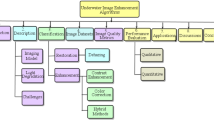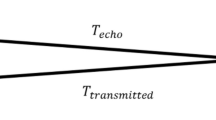Abstract
Atmospheric turbulence removal remains a challenging task, because it is very difficult to mitigate geometric distortion and remove spatially and temporally variant blur. This paper presents a novel strategy for atmospheric turbulence removal by characterizing local smoothness, nonlocal similarity and low-rank property of natural images. The main contributions are three folds. First, a joint regularization model is made which combines nonlocal total variation regularization and steering kernel regression total variation regularization in order that reference image enhancement and image registration are jointly implemented on geometric distortion reduction. Secondly, a fast split Bregman iteration algorithm is designed to address the joint variation optimization problem. Finally, a weighted nuclear norm is introduced to constrain the low-rank optimization problem to reduce blur variation and generate a fusion image. Extensive experimental results show that our method can effectively mitigate geometric deformation as well as blur variations and that it outperforms several other state-of-the-art turbulence removal methods.










Similar content being viewed by others
References
Han M, Lyu Z, Qiu T, Xu M (2018) A review on intelligence dehazing and color restoration for underwater images. IEEE Trans Man Cybern Part A Syst Hum 50:1820–1832
Yuan Q, Zhang L, Shen H (2014) Hyperspectral image denoising with a spatial spectral view fusion strategy. IEEE Trans Geosci Remote Sens 52(5):2314–2325
Li W, Zhang D, Liu Z, Qiao X (2005) Fast block-based image restoration employing the improved best neighborhood matching approach. IEEE Trans Syst Man Cybern Part A Syst Hum 35(4):546–555
Hong J, Cho S, Cho U (2009) A novel evolutionary approach to image enhancement filter design: method and applications. IEEE Trans Syst Man Cybern Part B Cybern 32(11):1446–1457
Bue BD, Thompson DR, Eastwood M, Green RO (2015) Real-time atmoshperic correction of AVIRIS-NG imagery. IEEE Trans Geosci Remote Sens 53(12):6419–6428
Zhu X, Milanfar P (2013) Removing atmospheric turbulence via space-invariant deconvolution. IEEE Trans Pattern Anal Mach Intell 35:157–170
Molina R, Nunez J, Cortijo FJ, Mateos J (2001) Image restoration in astronomy: a Bayesian perspective. IEEE Signal Process Mag 18:11–29
Pantin E, Starck J-L, Murtagh F (2007) Deconvolution and blind deconvolution in astronomy. In: Blind image deconvolution: theory and applications, pp 100–138
Li D, Mersereau RM, Simske S (2007) Atmospheric turbulence-degraded image restoration using principal components analysis. IEEE Geosci Remote Sens Lett 4:340–344
Harmeling S, Hirsch M, Sra S, Scholkopf B (2009) Online blind deconvolution for astronomical imaging. In: IEEE international conference on in computational photography, pp 1–7
Tahtali M, Lambert A, Fraser D (2008) Self-tuning Kalman filter estimation of atmospheric warp. In: Proceedings of SPIE, vol 70760F
Mao Y, Gilles J (2012) Non rigid geometric distortions correction-application to atmospheric turbulence stabilization. Inverse Probl Imaging 6:531–546
Shimizu M, Yoshimura S, Tanaka M, Okutomi M (2008) Super-resolution from image sequence under influence of hot-air optical turbulence. In: IEEE conference on computer vision and pattern recognition, pp 1–8 (2008)
Zhu X, Milanfar P (2010) Image reconstruction from videos distorted by atmospheric turbulence. In: Proceedngs of SPIE, vol 7543
Hirsch M, Sra S, Scholkopf B, Harmeling S (2010) Efficient filter flow for space-variant multiframe blind deconvolution. In: CVPR
Roggemann MC, Stoudt CA, Welsh BM (1994) Image-spectrum signal-to-noise-ratio improvements by statistical frame selection for adaptive-optics imaging through atmospheric turbulence. Opt Eng 33:3254–3264
Vorontsov MA, Carhart GW (2001) Anisoplanatic imaging through turbulent media: image recovery by local information fusion from a set of short-exposure images. J Opt Soc Am 18(6):1312–1324
Tubbs RN (2003) Lucky exposures: diffraction limited astronomical imaging through the atmosphere. arXiv:astro-ph/0311481
Fried DL (1978) Probability of getting a lucky short-exposure image through turbulence. J Opt Soc Am 68:1651–1657
Joshi N, Cohen M, Rainier SM (2010) Lucky imaging for multi-image denoising, sharpening, and haze removal. In: IEEE international conference of computational photography
Aubailly M, Vorontsov MA, Carhart GW, Valley MT (2009) Automated video enhancement from a stream of atmospherically-distorted images: the lucky-region fusion approach. In: Proceedings of SPIE—the international society for optical engineering, vol 7463
Xie Y, Zhang W, Tao D, Hu W, Qu Y, Wang H (2016) Removing turbulence effect via hybrid total variation and deformation-guided kernel regression. IEEE Trans Image Process 25(10):4943–4958
Gu S, Zhang L, Zuo W, Feng X (2014) Weighted nuclear norm minimization with application to image denoising. In: IEEE conference on computer vision and pattern recognition, pp 2862–2869
Cands EJ, Li X, Ma Y, Wright J (2011) Robust principal component analysis? J ACM 58:11
Wang S, Zhang L, Liang Y (2012) Nonlocal spectral prior model for low-level vision. ACCV 2012:231–244
Mao Y, Gilles J (2012) Non rigid geometric distortions correction-application to atmospheric turbulence stabilization. Inverse Probl Imaging 6(3):531–546
Myronenko A, Song X (2010) Intensity-based image registration by minimizing residual complexity. IEEE Trans Med Imaging 29(11):1882–1891
Takeda H, Farsiu S, Milanfar P (2007) Kernel regression for image processing and reconstruction. IEEE Trans Image Process 16:349–366
Goldstein T, Osher S (2009) The split Bregman method for L1-regularized problems. SIAM J Imaging Sci 2:323–343
Gilboa G, Osher S (2008) Nonlocal operators with applications to image processing. Multisc Model Simul 7:1005–1028
Xie Y, Qu Y, Tao D, Wu W, Qu Y, Zhang W (2016) Hyperspectral image restoration via sparse and low-rank matrix recovery. IEEE Trans Geosci Remote Sens 54(8):4642–4659
Shan Q, Jia J, Agarwala A (2008) High-quality motion deblurring from a single image. In: ACM transactions on graphics, p 73
Nagy JG, Oleary DP (1997) Fast iterative image restoration with a spatially varying PSF. In: International society for optics and photonicsin, advanced signal processing: algorithms, architectures, and implementations VII, vol 3162, pp 388–399
Stockham Jr TG (1966) High-speed convolution and correlation. In: Proceedings of spring joint computer conference, pp 229–233
Oreifej O, Shu G, Pace T, Shah M (2011) A two-stage reconstruction approach for seeing through water. In: IEEE conference on in computer vision and pattern recognition, pp 1153–1160
Acknowledgements
This work is supported by the National Key Research and Development Program of China No. 2020AAA0108301, the National Natural Science Foundation of China under Grant Nos. 61876161 and 61772524, the Natural Science Foundation of Shanghai (20ZR1417700), the CAAI-Huawei MindSpore Open Fund and the Fundamental Research Funds for the Central Universities.
Author information
Authors and Affiliations
Corresponding author
Ethics declarations
Conflict of interest
The authors declare that they have no conflict of interest.
Additional information
Publisher's Note
Springer Nature remains neutral with regard to jurisdictional claims in published maps and institutional affiliations.
Rights and permissions
About this article
Cite this article
Qu, Y., Yang, W., Xie, Y. et al. Joint regularization and low-rank fusion for atmospheric turbulence removal. Neural Comput & Applic 35, 23369–23385 (2023). https://doi.org/10.1007/s00521-021-06336-5
Received:
Accepted:
Published:
Issue Date:
DOI: https://doi.org/10.1007/s00521-021-06336-5




